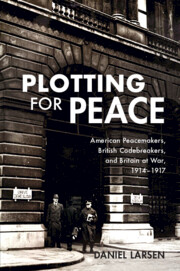Book contents
- Plotting for Peace
- Plotting for Peace
- Copyright page
- Dedication
- Contents
- Figures
- Map
- Graph and Table
- Dramatis Personae
- Preface
- Acknowledgements
- Maps
- Introduction
- 1 The First Year of War
- 2 Strategy
- 3 Negotiations
- 4 Deliberations
- 5 The Gamble
- 6 The Knock-Out Blow
- 7 The Fall of Asquith
- 8 Peace Moves
- 9 The Zimmermann Telegram and Wilson’s Move to War
- Conclusion
- Book part
- Notes
- Bibliography
- Index
7 - The Fall of Asquith
October–December 1916
Published online by Cambridge University Press: 26 March 2021
- Plotting for Peace
- Plotting for Peace
- Copyright page
- Dedication
- Contents
- Figures
- Map
- Graph and Table
- Dramatis Personae
- Preface
- Acknowledgements
- Maps
- Introduction
- 1 The First Year of War
- 2 Strategy
- 3 Negotiations
- 4 Deliberations
- 5 The Gamble
- 6 The Knock-Out Blow
- 7 The Fall of Asquith
- 8 Peace Moves
- 9 The Zimmermann Telegram and Wilson’s Move to War
- Conclusion
- Book part
- Notes
- Bibliography
- Index
Summary
A sense of crisis emerged amidst growing anxieties over the Allied financial, shipping, and food situations. The British faced hard economic choices for the coming year, but the Cabinet remained divided and paralyzed. Lord Lansdowne finally put to paper the worries that had filled a number of ministers all year: the 'Lansdowne Memorandum' called for a consideration of a negotiated peace, finding a number of supporters within the Cabinet and sparking vigorous debate. Lloyd George rejected Lansdowne's position, determined to force the adoption of industrial conscription and to increase British spending in the United States. Lloyd George rejected the reality of Britain's increasingly fragile economic position even amidst a serious financial crisis. Plotting with Conservative leader Andrew Bonar Law and with Edward Carson, Lloyd George sought to eject Asquith and his supporters from the levers of power, but Asquith outmanoeuvred him, holding his government together with a series of compromises and isolating Lloyd George within the Cabinet. Lloyd George responded by launching a desperate gambit to remove Asquith's control over the war. When the dust settled, Lloyd George was on Downing Street.
Keywords
- Type
- Chapter
- Information
- Plotting for PeaceAmerican Peacemakers, British Codebreakers, and Britain at War, 1914–1917, pp. 188 - 245Publisher: Cambridge University PressPrint publication year: 2021



